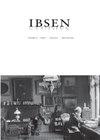Democratisation Process in Interculturalism: Staging Ibsen within a Folk Theatrical form in Bangladesh
IF 0.1
0 THEATER
引用次数: 1
Abstract
In this article, I will focus on the transformation process taking place within what I earlier have called complex forms of cultural encountering within theatre, that is, when a text from one culture is blended with a theatrical form from another culture. In the example used, the encounter is between Ibsen’s text, Ghosts (Gengangere) and a folk theatrical form of Bangladesh called Kushan Gan. Kushan Gan is a genre of popular performance in which episodes from the Ramayana are mostly enacted. It is performed during religious festivals of various deities including Kali, Bhagavati (Durga), Laksmi, Jagaddhatri and Saraswati. It is usually performed in the temple precinct or in the outer courtyard of homesteads. Kushan Gan is further described in Syed Jamil Ahmed’s Achinpakhi Infinity: Indigenous Theatre of Bengal (2000, 61–62). It is important to note that the production was made by traditional artists for a local audience. I will argue that the encountering process can be analysed by making use of the three-step approach of separation, replacement and incorporation. Through this process, the traditionally religious content of the particular folk form is replaced by a secular and reinterpreted Ibsen text which is presented through the artistic expression typical for this art form. In this way, Ibsen’s text becomes purely localised and clearly also political.跨文化主义中的民主化进程:易卜生在孟加拉国民间戏剧形式中的演出
在这篇文章中,我将把重点放在我之前所说的戏剧中文化相遇的复杂形式中发生的转变过程,也就是说,当一种文化的文本与另一种文化的戏剧形式混合在一起时。在这个例子中,易卜生的作品《鬼》(Gengangere)和孟加拉国民间戏剧形式Kushan Gan之间的相遇。Kushan Gan是一种流行的表演类型,其中大部分是罗摩衍那的情节。它在各种神灵的宗教节日期间进行,包括Kali, Bhagavati (Durga), Laksmi, Jagaddhatri和Saraswati。它通常在寺庙区或在宅院的外院进行。在Syed Jamil Ahmed的Achinpakhi Infinity: Indigenous Theatre of Bengal(2000,61 - 62)中进一步描述了Kushan Gan。值得注意的是,这部作品是由传统艺术家为当地观众制作的。我认为,可以通过使用分离、替换和合并三步法来分析相遇过程。通过这一过程,特定民间形式的传统宗教内容被一种世俗的、重新诠释的易卜生文本所取代,这种文本通过这种艺术形式的典型艺术表现来呈现。通过这种方式,易卜生的文本变得纯粹本土化,而且显然也是政治性的。
本文章由计算机程序翻译,如有差异,请以英文原文为准。
求助全文
约1分钟内获得全文
求助全文

 求助内容:
求助内容: 应助结果提醒方式:
应助结果提醒方式:


